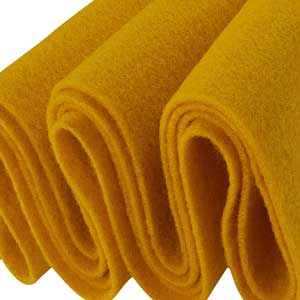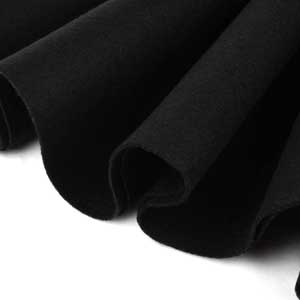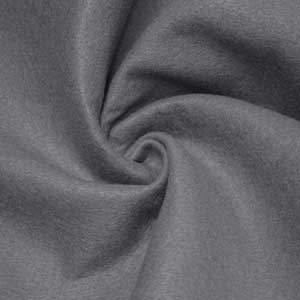We always pay attention to the fabric of the clothes when we are going to buy them online. We know that pure cotton is a kind of fabric. But, everyone may not be familiar with acrylic fiber. Sometimes, we do not even realize that those big, fluffy sweaters we love to wear in winter contain acrylic fibers. So, Let’s start with the most basic question, what is the acrylic fabric?
Acrylic fabric is a synthetic material that contains a higher percentage of acrylonitrile monomers. It serves as an excellent substitute for wool. You will find acrylic fabric commonly used in hoodies, sweaters, jackets, socks, etc.
To know more about acrylic fabric, what it is made of, the key features, advantages, disadvantages, continue to read our article. You will learn everything about acrylic fabric so you know what you and your loved ones are wearing every day.
Read More: Best Fabric for Screen Printing Reviews
What is Acrylic Fabric?
Acrylic fabric is a fabric woven or knitted with acrylic yarns that results in thick and warm material. It is made artificially through a synthetic polymer called acrylonitrile. Acrylonitrile is produced from certain petroleum or coal-based chemicals. Acrylic fabric is a fossil fuel-based fiber. It has no natural source.
Since acrylic is not a breathable fabric, it is more suitable for heat-retention applications. It provides incredible warmth and insulation. You usually see tracksuits, athletic pants, and hoodies made from acrylic fabric.
Acrylic was developed first during the second world war. In the early 1950, it became too popular although people could only wear it in winters.
How is Acrylic Fabric Made?
A polymer of acrylonitrile known as polyacrylonitrile produces in a water-based solution. It occurs using a reaction technique called free radical polymerization. Then, a powerful chemical solvent dissolves this polymer which results in a gel-like material. The gel-like material is then ready to extrude through a spinner to form acrylic fibers. These fibers are coagulated using the same solvent, which is known as wet spinning.
To use a more environmentally friendly and efficient process, manufacturers also go for dry spinning. It includes evaporating the solvent with a stream of heated gas. Then the resulting fibers undergo washing, stretching, and crimping processes. Crimping makes the fibers long, thin filaments that are ready to spin into yarn. The manufacturers weave this yarn into clothing, carpeting, or a variety of other applications.
What Does Acrylic Fabric Feel Like?
Gone are the days when acrylic was an itchy and scratchy material. Modern acrylic feels soft and smooth. It brings a nice feeling to your skin when you wear acrylic fabric clothing items. Acrylic socks are a great option to wear. When you are outside clearing the snow off your car, you can keep your feet nice and warm. A good acrylic sweater feels nice and soft. If you want to save your heating bill, the acrylic blanket is a good option. But of course, softness is a subjective feeling. What feels soft to one person may not feel soft to another.
Acrylic Fabric Properties
- Acrylic fabric is lightweight, soft, and warm that feels good to the touch. It almost resembles the look and feels of wool fibers.
- 100% acrylic fabric is well-known due to its incredible insulating properties. This insulating ability depends on the style of the garment. A fabric with close weaves and a garment that sticks to your skin will trap heat next to your body.
- Acrylic lacks breathability. It does not easily allow air to flow through it. So, this also causes heat to trap between the fabric and your skin. It can make you hot very quickly.
- You can easily take care of the acrylic fabric. It dries quickly and contains hydrophobic features. You cannot say it is waterproof. It does not easily absorb water either.
- Acrylic also resists stains, mold, and odor.
- It lasts a long time and remains durable.
- Acrylic costs you lesser than wool or other natural fibers.
What is Acrylic Fabric Used For?
- As you already know, apparel manufacturers make acrylic fibers into cold-weather clothing like sweaters, hoodies, gloves, mittens, pants, hats, etc.
- Acrylic fabric is also a popular material for household products like upholstery, carpeting, rugs, blankets, and pile fabrics.
- Acrylic fiber has some industrial uses as well. It includes filtration materials, reinforcement materials in construction, and car batteries.
- Manufacturers can make types of acrylic that look like fur. You can use props or costumes made of acrylic fabric.
- Some outdoor applications of acrylic include car tops, boat covers, awnings, and outdoor furniture.
- Many unprofessional knitters use acrylic as a learner fiber. They also use it as a yarn for cheap and low-effort projects.
- You can even find acrylic in wigs, hair extensions, hairbrushes.
Acrylic Fabric Advantages and Disadvantages
Advantages
- The acrylic fabric has much better elasticity as compared to wool. It has a better resilience in the case of large stretches.
- Acrylic is highly insulating and the warmest man-made fabric. It has an excellent softness to the touch.
- Acrylic is highly resistant to sunlight which means it has excellent lightfastness. If you expose the acrylic fabric to the sun, it will not fade easily.
- In addition to lightfastness, acrylic is also resistant to destructive forces like mildew, moth, and mold.
- Acrylic fabric does not wrinkle. If you are traveling, you can pack a hoodie in your suitcase.
- Acrylic holds its color well. It does not bleed onto the other clothes in the wash.
- Acrylic fabric is easy to clean. You can wash this fabric in your washing machine.
- It does not easily absorb water and protects from some elements.
Disadvantages
- Acrylic is sensitive to heat. It can melt into molten plastic when it gets too hot.
- Some acrylic fabrics are prone to pilling. The tiny bobbles of thread will peel off the fabric and collect on its surface over time. You can prevent them from peeling off by turning clothes inside out before washing. You can also air dry them.
- If you put the acrylic fabric in the dryer, it is also prone to static cling.
- The air permeability of acrylic fibers is not good. But it enables some of its insulating properties.
- Acrylic fiber is not alkali-resistant. You cannot use alkaline detergent when washing.
- The manufacturing process of acrylic causes environmental pollution.
How to Clean Acrylic Fabric?
Read the care labels first and follow the washing instructions for that specific garment. Most acrylic clothes are machine-washable. Here are the steps for how to wash acrylic fabric with care.
Pretreat Stains
Pretreat the stains first if you notice any old or stubborn stains. You can use dry cleaning solvent, rubbing alcohol, or a clean toothbrush to remove the stains.
Choose Laundry Detergent and Load the Washer
Use your favorite laundry detergent to clean acrylic clothes. For clothes that are heavily soiled, a heavy-duty detergent will be more effective to remove soil. You can use a heavy-duty detergent like Tide or Persil. Acrylic fibers can build up static. So, use a small amount of fabric softener in the final rinse cycle to prevent clinginess.
Select a Water Temperature and Wash Cycle
You can use warm or cold water to wash acrylic garments. Select the permanent press cycle to avoid wrinkles that are difficult to remove. If your washer has a high spinning rate for the final cycle, set the spin cycle rate to low.
Check for Stains After Washing
Check your clothes for any remaining stains before you toss them in a dryer. If you place an acrylic garment stained with oil in a dryer, heat can set the oil stain permanently to your clothes.
Select a Drying Cycle
Tumble dry your acrylic clothes at low temperatures. Excessively high heat may damage fibers and cause them to stretch or shrink. The best way is to remove the clothes when they are slightly damp and hang them to finish air-drying.
Choose the Ironing Temperature
If you think ironing is necessary, use the lowest iron temperature. Also, use a pressing cloth and steam to prevent the fibers from melting. You cannot reverse the damage if a fabric becomes shiny or develops a hole.
Recommended Acrylic Fabric
FabricLA Acrylic Felt Fabric
This felt fabric is made from synthetic fibers that are 100% acrylic. These fibers have a higher density than most other synthetic crafting felts. So, it offers excellent durability. You can easily cut, fold, glue, and sew without unraveling or creasing. It is a great material for making home decorations like artificial flowers, coasters, tissue boxes, and gifts. You can iron this acrylic fabric at a low temperature. It is very safe for kids. Kids can create alphabets, soft books, soft animals, and toys from the felt. This felt fabric is perfect for beginners, intermediate, and advanced crafters. Slight color variations may occur.
Barcelonetta Acrylic Felt Fabric
Barcelonetta acrylic felt is also 100% acrylic. As long as the stain is not oil-based, it is resistant to stain.
You can machine wash the fabric with cold water on a gentle cycle.
Fill the water in the washer to cover the felt. Run the felt through the complete washing cycle.
Then just air dry. It washes well and does not shrink.
The plastic fibers themselves hold the color. You do not need to worry about the color fading issue.
AK Trading Acrylic Felt Fabric
With this 100% acrylic craft felt fabric, you can give a beautiful look to all your crafting projects.
Its high-density synthetic fibers provide great durability than regular store-bought acrylic felt.
You can manipulate, cut, and glue with ease.
It is used for costumes, bows, decorations, flower pots, book covers, toys, accessories, and anything you can imagine.
This fabric gives your projects a more attractive and strong look. It makes crafting more fun and creative.
Conclusion
Now, you are familiar with everything about what is acrylic fabric. Acrylic is a popular alternative to wool. But It is not as good as that fabric for clothing. Yet, it helps you save money and stay warm throughout the winter. Like every other thing in the world, acrylic also comes with pros and cons. Since you know them, you can decide whether you want to get acrylic clothes or not. Like all fabrics, there will be materials that are better than others. You have to select between the top-quality acrylic fabrics and the bad ones. Good Luck to you!


